
Yes well there's some truth in that.
However it raises an interesting question. The 5 series was always the GP camera model that was good for most applications, and an awful lot are used to photograph weddings, the FF giving such an advantage in dimly lit churches. If the R5 really is the 5DIV's replacement then it's jumped to 45mp, and the difference between 45 and 50mp is basically nothing in both terms of resolution, output size and processing speed ! So 5 series users, often shooting hundreds of images at a time, are now 'lumbered' with 45mp data to deal with. Maybe CRAW is coming to the rescue here ? The problem with the previous MRAW & SRAW was that only DPP seemed to be able to convert them properly and even then there are issues so it wasn't really a viable option for many, myself included.
So it looks to me as if 5 series photographers are going to be forced into becoming data masochists in the future !





